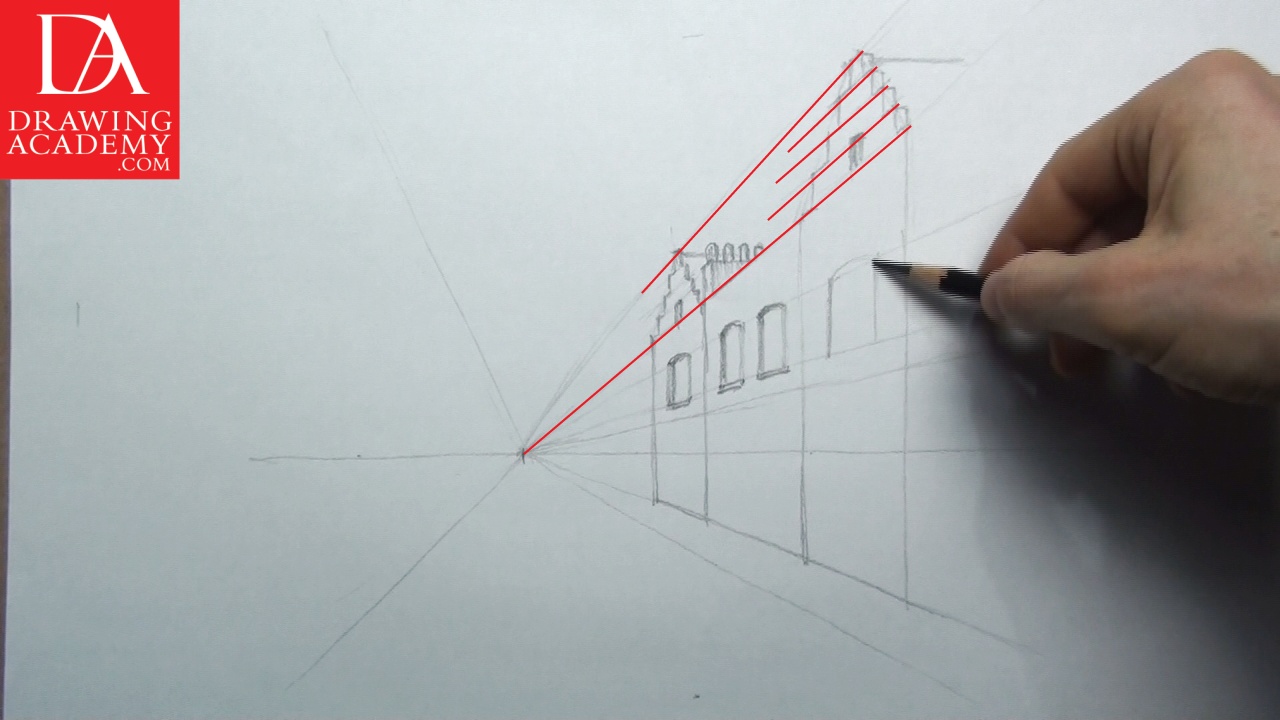One-Point Perspective – Linear Perspective Drawing
In this video lesson, you will discover how to use one-point perspective in a cityscape drawing.
Enroll in the Drawing Academy Course
Pay once - Enjoy forever!
Only $297
Linear perspective drawing – Cityscape in one-point perspective
This one-point perspective cityscape will be drawn in relation to the horizontal line that represents the viewer’s eye level. The one-point perspective vanishing point is located right in front of the viewer on this line representing the horizon. All other perspective lines will radiate from this one-point perspective dot. This is the only vanishing point we will use for this drawing; therefore the drawing is called one-point perspective drawing.

When drawing in one-point perspective, all vertical lines are positioned at the right angle to the horizon. In real life this would be the case only for a vertical line straight in front of the viewer. All other vertical lines would have a slight tilt toward two vanishing points far above and far below the horizon line. Nevertheless, human brain perceives all those vertical lines as being true vertical and fine artists are using this approximation in most cases.
The roof’s ridge cap is illustrated as a horizontal line. This is also approximation in one-point perspective. The building is far enough and positioned in such a way that horizontal lines will look natural and acceptable by a spectator.
According to rules of one-point perspective, sloped lines are running from the vanishing point; they mark top and bottom edges of windows.
Windows’ side edges are vertical. The bottom edges are arranged on the perspective line in one-point perspective, and top edges are slightly curved upward.
Note how bigger the windows appear the closer to the foreground they are.
The width of the house on the right hand side is depicted bigger than the width of the identical house that is closer to the vanishing point in one-point perspective. This perfectly illustrates the rule of one-point perspective that objects become smaller the further they are from the viewer.
A stepped gable of the roof is also drawn in perspective. Every corbie-step and a small window at the top have lines that tilted in the direction of the vanishing point.
In our one-point perspective, the side plane of the semi-detached building is depicted flat without any distortion. This is again another approximation.
The window on this side appears as an undistorted rectangle. The top side of the window is slightly curved upwards; this is a window’s design unrelated to a foreshortening in one-point perspective. The location of this window is marked by two horizontal lines that originate at points where sloped perspective lines cross the vertical line of the building’s corner.
The arched doorway is following the one point perspective. Note that the horizon line goes near the topside of the door. This shows that the viewer observes this cityscape from the street level.
The ground floor window is as wide as two windows of the first floor. The top edge of this window is sloped downward as it is positioned above the horizon line and therefore above the viewer’s eye level in one-point perspective. The window’s bottom edge is depicted as a sloping line going upward because it is located below the eye level. Both these lines are aiming toward the vanishing point.
The pavement next to the semi-detached house follows perspective line that is radiated from the vanishing point of the one-point perspective system.
Four pavement bollards are also following the same perspective rule. Bollards on the drawing are becoming bigger on the drawing and as the distance between them increases the closer to the viewer they are. In real life all four bollards are identical with and have equal distances between them.




